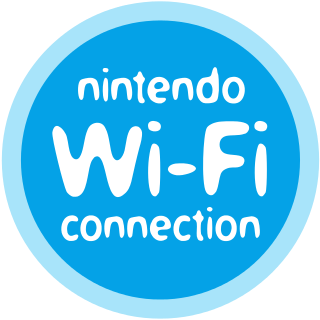Other uses
- World Federation of the Deaf, a non-governmental organisation
- World's Fastest Drummer, a series of sporting competitions
WFD may stand for:

IEEE 802.11 is part of the IEEE 802 set of local area network (LAN) technical standards, and specifies the set of media access control (MAC) and physical layer (PHY) protocols for implementing wireless local area network (WLAN) computer communication. The standard and amendments provide the basis for wireless network products using the Wi-Fi brand and are the world's most widely used wireless computer networking standards. IEEE 802.11 is used in most home and office networks to allow laptops, printers, smartphones, and other devices to communicate with each other and access the Internet without connecting wires. IEEE 802.11 is also a basis for vehicle-based communication networks with IEEE 802.11p.

A wireless LAN (WLAN) is a wireless computer network that links two or more devices using wireless communication to form a local area network (LAN) within a limited area such as a home, school, computer laboratory, campus, or office building. This gives users the ability to move around within the area and remain connected to the network. Through a gateway, a WLAN can also provide a connection to the wider Internet.

Wireless community networks (WCNs) or wireless community projects or simply community networks, are non-centralized, self-managed and collaborative networks organized in a grassroots fashion by communities, NGO's and cooperatives in order to provide a viable alternative to municipal wireless networks for consumers.

Wi-Fi is a family of wireless network protocols based on the IEEE 802.11 family of standards, which are commonly used for local area networking of devices and Internet access, allowing nearby digital devices to exchange data by radio waves. These are the most widely used computer networks in the world, used globally in home and small office networks to link devices together and to a wireless router to connect them to the Internet, and in wireless access points in public places like coffee shops, hotels, libraries, and airports to provide visitors with Internet connectivity for their mobile devices.

In computer networking, a wireless access point, or more generally just access point (AP), is a networking hardware device that allows other Wi-Fi devices to connect to a wired network. As a standalone device, the AP may have a wired connection to a router, but, in a wireless router, it can also be an integral component of the router itself. An AP is differentiated from a hotspot which is a physical location where Wi-Fi access is available.

The Wi-Fi Alliance is a non-profit organization that owns the Wi-Fi trademark. Manufacturers may use the trademark to brand products certified for Wi-Fi interoperability. It is based in Austin, Texas.

D-Link Systems, Inc. is a Taiwanese multinational networking equipment corporation founded in 1986 and headquartered in Taipei, Taiwan.

A hotspot is a physical location where people can obtain Internet access, typically using Wi-Fi technology, via a wireless local-area network (WLAN) using a router connected to an Internet service provider.

Nintendo Wi-Fi Connection (WFC) was an online multiplayer gaming service run by Nintendo to provide free online play in compatible Nintendo DS and Wii games. The service included the company's Wii Shop Channel and DSi Shop game download services. It also ran features for the Wii and Nintendo DS systems.
WFC may refer to:

My Life Online (Mylo) was a device created and marketed by Sony for portable instant messaging and other Internet-based communications, browsing Internet web sites using the Opera web browser and playback and sharing of media files. The pocket-sized, tablet-shaped handheld device, which debuted in 2006, had a screen which slid up to reveal a QWERTY keyboard. The brand name 'Mylo' means My Life Online. Using Wi-Fi instead of cellular networks, the Mylo was targeted to the 18–24 age group.

Eye-Fi was a company based in Mountain View, California, that produced SD memory cards with Wi-Fi capabilities. Using an Eye-Fi card inside a digital camera, one could wirelessly and automatically upload digital photos to a local computer or a mobile device such as a smartphone or tablet computer. The company ceased business in 2016.
Wi-Fi Direct is a Wi-Fi standard for peer-to-peer wireless connections that allows two devices to establish a direct Wi-Fi connection without an intermediary wireless access point, router, or Internet connection. Wi-Fi Direct is single-hop communication, rather than multi-hop communication like wireless ad hoc networks.

AirDrop is a proprietary wireless ad hoc service in Apple Inc.'s iOS and macOS operating systems, introduced in Mac OS X Lion and iOS 7, which can transfer files among supported Macintosh computers and iOS devices by means of close-range wireless communication. This communication takes place over Apple Wireless Direct Link 'Action Frames' and 'Data Frames' using generated link-local IPv6 addresses instead of the Wi-Fi chip's fixed MAC address.
Miracast is a standard for wireless connections from sending devices to display receivers, introduced in 2012 by the Wi-Fi Alliance. It can roughly be described as "HDMI over Wi-Fi", replacing the cable from the device to the display.

The Checkout was an Australian consumer affairs television series. The show's first series of 10 episodes premiered on 21 March 2013 on the Australian Broadcasting Corporation (ABC) television station ABC TV. A second series consisting of 16 episodes commenced airing on 20 February 2014. On 9 April 2015, a third series consisting of 12 episodes began airing. The series was renewed for a fourth series, which began airing on 7 April 2016 consisting of 12 episodes. The series returned for a fifth series, airing twelve episodes between 6 April 2017 and 29 June 2017. The Checkout, with a new look, logo, opening theme and art, still retaining original cast and segments, returned for a sixth season on 30 January 2018.
Smartphone ad hoc networks are wireless ad hoc networks that use smartphones. Once embedded with ad hoc networking technology, a group of smartphones in close proximity can together create an ad hoc network. Smart phone ad hoc networks use the existing hardware in commercially available smartphones to create peer-to-peer networks without relying on cellular carrier networks, wireless access points, or traditional network infrastructure. Wi-Fi SPANs use the mechanism behind Wi-Fi ad-hoc mode, which allows phones to talk directly among each other, through a transparent neighbor and route discovery mechanism. SPANs differ from traditional hub and spoke networks, such as Wi-Fi Direct, in that they support multi-hop routing and relays and there is no notion of a group leader, so peers can join and leave at will without destroying the network.
WiFi Master is a peer-to-peer Wi-Fi sharing mobile application software for free Wi-Fi access developed by LinkSure Network. It uses cloud computing, big data and principles of the sharing economy. The company's founder and CEO, Chen Danian, was previously CEO and co-founder of Shanda.
In cryptography, Simultaneous Authentication of Equals (SAE) is a password-based authentication and password-authenticated key agreement method.

Nearby Share is a service developed by Google that allows data to be transferred between devices via Bluetooth and Wi-Fi. It is available on their mobile and desktop operating systems, Android and ChromeOS, as well as Microsoft's Windows. Nearby Share uses Bluetooth, Bluetooth Low Energy, WebRTC, UWB, and peer-to-peer Wi-Fi to allow users to share files and links between devices. It was first released on August 4, 2020.